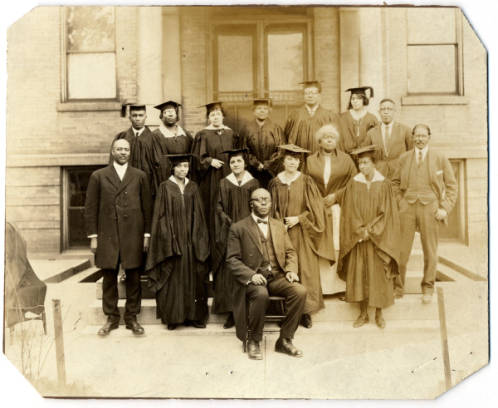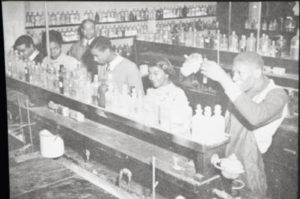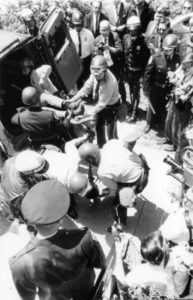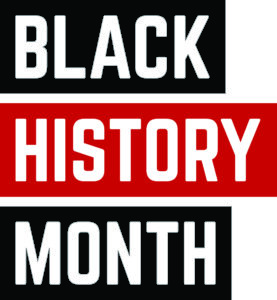
Editor’s note: What does Black History Month mean in the context of the University of Louisville? Some highlights from “University of Louisville Belknap Campus,” by Tom Owen and Sherri Pawson, and “The University of Louisville,” by Dwayne D. Cox and William J. Morison illustrate part of this history. We’ve distilled some information from those two books into a story depicting our history and how it was shaped by the contributions of African American community members, faculty, staff and students.
Did you know that UofL’s current Belknap Campus location was determined in large part by Louisville’s African American voters?
When Arthur Ford was the university’s president (1914-1926), one of his major initiatives was to seek increases in city appropriations for the university, citing inadequate physical facilities and increasing enrollment. By the fall of 1920, student enrollment exceed 600, and the college had outgrown its home at Second and Broadway streets downtown.
The family of William R. Belknap, a local hardware dealer who had recently died, donated funds for the school to acquire a 79-acre tract in Louisville’s Highlands neighborhood, prompting the university to submit a $1 million municipal bond to develop the campus. But voters, especially African American ones, defeated that 1920 bond proposal at the polls.
At the time, African Americans were prevented by state law from attending the university, despite paying city taxes. Essentially, black Louisvillians who cast the deciding votes refused to support an institution they could not attend.
“Awareness of the growing political and economic strength of African Americans during and after WWI had eluded UofL officials. Just as they had not reckoned with this black renaissance, they also had failed to take account of the rise of a new generation of black leaders, who relied on fellow blacks, rather than influential whites, for support,” the Cox and Morison book notes.
After this defeat, President Ford assured black opponents that if the issue were passed on a future ballot, a portion of the money would be set aside to support higher education for African Americans. The bond passed in 1925, but Ford died shortly after and his promise went unfulfilled, save for a provision of extension classes at Simmons University.
Discouraged by their defeat at the ballot box, university officials in 1923 sold the Highlands property acquired through the Belknap family, which was quickly developed as a University Park – a residential area that now includes Princeton, Yale, Harvard and Sewanee streets.
The university’s Plan B was to purchase property at Third and Shipp streets, which disappointed the Belknaps, the book notes. However, President Ford believed he lacked the resources to develop a completely new campus, even if the bond was resubmitted and approved.
As such, the Belknap Campus today is largely accessible via Third Street, while the formal address of the Belknap Academic Building is 201 E. Shipp Street Walk.
Louisville Municipal College for Negroes
President Raymond Asa Kent (1929-1943) fulfilled President Ford’s earlier pledge to provide higher education for African Americans by establishing the Louisville Municipal College for Negroes in 1931.
This was the period of the mass migration of blacks out of the rural South. By this time, “The University of Louisville” book notes, school segregation had been burned into Kentucky law, fueled by the 1904 Day Law prohibiting the teaching of both whites and blacks in the same school.
The Day Law, which survived an appeal to the U.S. Supreme Court in 1908, “effectively and devastatingly ended black higher education in Kentucky” with the exception of the State Normal School for Colored Persons in Frankfort, and Simmons University in Louisville.
Simmons, originally the Kentucky Normal and Theological Institute, opened in 1879, and eventually offered training in medicine and law. Charles H. Parrish Sr. was named president in 1918, and the school was renamed in honor of the school’s first president, William J. Simmons. However, the school struggled to secure funds necessary to meet accreditation standards.
Black leaders met with UofL officials in 1926 and 1927, urging them to revisit Ford’s promise to provide higher education to African Americans. Eventually Kent acted in 1929 with the establishment of the Louisville Municipal College.
Louisville Municipal College for Negroes opened in 1931 on the site at Seventh and Kentucky Streets. The first students – 83 of them – enrolled in Louisville Municipal College for Negroes on Feb. 9, 1931.

The first graduate was Florence Johnson, who received her bachelor’s degree in chemistry in 1932.
Functioning as a “separate institution under the administration of the board of trustees of the University of Louisville,” it was the only full-fledged black liberal arts college in Kentucky and the only one in the nation supported by city funds.
In 1936, LMC was granted full accreditation by the Southern Association of Colleges and Secondary Schools. In 1942, the UofL board of trustees removed the words “for Negroes” from the school’s name after LMC students petitioned for the revision.
Additionally, it was at that point when the students’ diplomas were changed to read “University of Louisville,” rather than “Louisville Municipal College for Negroes.”
For two decades, however, LMC would remain a segregated undergraduate division of the University of Louisville.
The school bustled with student activities, including clubs, debate teams, theatre arts, fraternities, sororities and athletics. In fact, On New Year’s Day in 1947, LMC played its first college bowl game, which means it was the first bowl game played by any UofL squad.
A number of factors led to the closing of LMC and the integration of all UofL academic units in 1950 and 1951; namely, the high cost of running two separate colleges and the idea of integration gaining favor. Following WWII, the Louisville chapter of the NAACP pressed UofL to open its graduate and professional schools to blacks.
In 1949, President John W. Taylor and the trustees were split on the issue. Taylor favored integration and student sentiment toward integration was also growing. The Student Council permitted a vote on a referendum on racial discrimination. A total of 2,136 out of 5,000 eligible students voted, the largest number in a campus election to that point. The measure failed by 46 votes, despite support from the student newspaper.
However, following challenges from the NAACP and with the support of the governor and lieutenant governor, legislation to add an amendment to the Day Law to integrate the university carried on March 2, 1950. With that passage, blacks could attend any Kentucky college so long as the institution’s trustees approved. At UofL, faculty and administrators, with the exception of the dental school, favored integration.
In April 1950, UofL trustees approved a schedule for the desegregation of the university, including the integration of graduate and professional schools by the fall of 1950. The Municipal College closed in the spring of 1951, and the college of Arts & Sciences enrolled its first black students in September of 1951.
President Taylor’s report claimed that the University of Louisville was “the first in the South to open all of its facilities to Negroes.”
Before it closed in 1951, the LMC had enrolled 2,649 students, 512 of whom graduated with degrees. Notably, “many more women than men attended.”
Only Charles H. Parrish Jr., a sociologist, was retained from the LMC, becoming UofL’s first black faculty member. Parrish retired in 1964.
Parrish Court, named in honor of him and located in the heart of the Belknap Campus, opened 1977.
Student unrest in the 1960s and 70s
Despite full integration, UofL was not immune to the racial tensions that proliferated in the U.S. in the late 1960s. In April 1968, UofL black student protesters urged the university to do more than highlight its few African American faculty members and high profile black athletes.

On March 4, 1969, the Black Student Union submitted a plan calling for more efforts to recruit minority students and teachers, increase financial aid for black students and offer new courses in black history and literature.
After the university failed to meet all of the BSU demands, on April 30, 1969, a group of students and other sympathizers occupied President Woodrow Strickler’s office for a few hours, then quietly left. The next day, 21 black students took over the A&S dean’s building and were forcibly removed by police. Some were arrested.
Blaine Hudson III, one of the black student leaders, later recalled that Strickler wanted to remedy past injustices, but couldn’t fully appreciate that the black students had legitimate complaints, rather expecting unrealistically quick results.
A the time of the confrontation, trustee Woodford R. Porter Sr., UofL’s first African American board member, warned that if moderate protesters were denied victories, more militant leaders would seize control of the Civil Rights Movement. One direct result of this series of protests was the creation of the Office of Black Affairs to assist in the recruitment of more black students and faculty, create tutoring programs and coordinate black studies in the curriculum.
The creation of the Multicultural Center
Although the specific plans and funding for the Multicultural Center were a direct result of discussions arising out of the 1991 Fiesta Bowl controversy (more on that here), that unit’s roots can be traced to the aftermath of an incident of racial prejudice which had occurred a year earlier.
In November 1989, a student reported she had been the target of racist notes to the effect that she did “not belong” in the Panhellenic dormitory. A freshman from Ohio, she was the only African American resident of that building at the time. In support of the student, more than 100 students conveyed a list of demands to President Swain, including calls to eliminate “the segregation of the Panhellenic dorm,” to increase the number of African American resident assistants, to institute penalties for racial harassment, to remove the Confederate Monument and rename the Confederate Apartments, and to create a facility for black students.
Swain responded that: “UofL will not tolerate any form of racial harassment. We must assure that UofL is a welcoming, supportive place for people of all races and ethnic backgrounds.”
Swain promised students the following:
- The Panhellenic dorm would be fully integrated.
- The number of resident assistants who were black would mirror the percentage of black students living in the dorms.
- The affected student’s dorm fees would be remitted.
- A multicultural center would be developed.
- The Confederate Apartments would be renamed University Tower Apartments.
- Those found guilty of racial harassment would be severely punished.
Swain noted that the university had no authority to move the monument, which had built on city property long before the university moved to the Belknap Campus site.
Nearly 30 years later, in November 2016, UofL and the city of Louisville removed the Confederate statue from Third Street on the western edge of campus.































